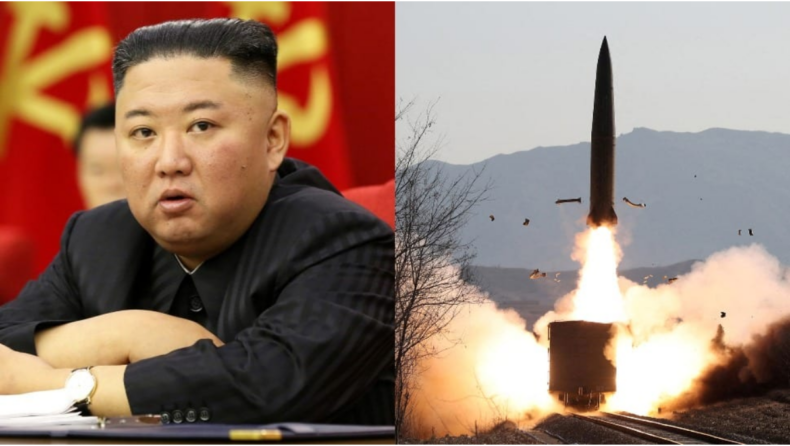Kim Jong-un, North Korea’s leader, said Thursday that “there would no longer be any bargaining over our nuclear power,” according to state media.
Recently the North Korean leader of “The Workers’ Party of Korea” implemented its nuclear weapon policy, which enables it to carry out preemptive nuclear strikes against any ostensible threats (regardless of nuclear or non-nuclear grade).
North Korea which has ramped up its weapon testing since 2017 following two major regime changes respectively in the U.S. (ascended by Donald Trump) and South Korea (ascended by Moon Jae-in), is blabbering its hymns of facile deterrence in the domain of global geopolitics, ever since the first ICBM missile test in 2017 Pyongyang has expanded its military actions.
And recently the newly elected South Korean President Yoon Suk-year (May/2022) seems to have been targeted by the harking comments of North Korea, about border issues and blaming the outbreak of COVID-19 on the former’s territory.
However, Seoul refusing to shun the brawl had very recently retorted that “preemptive strikes are common in global defense arena”, and “ensured to tackle back equally whenever needed”.
This depicts the unwise attempt to “unfetter the simmering nuclear beast” by instigating fatuous funds.
The dawn of denuclearization
The recently concluded TENTH CONFERENCE of the “Non-Proliferation Treaty (NPT)” (1/Aug – 26/Aug 2022 in New York) went inconclusive without any consensus among the member nations, this, however, is unsurprising as the global peace process had never converged at a common point of adherence.
The best examples are:-
- The Russian invasion of Ukraine,
- Japan, was unable to retrieve the “Kuril Islands” from Russia, which were ceded during the Second World War,
- Unrest in the Middle East (particularly between “Israel – Palestine”, “Saudi Arabia – Iran”),
- Violation of UNCLOS and territorial boundaries by China, claiming its dominance over the nations in the South-China Sea.
Amidst all the turmoil the ghoulish one remains to the threat of “nuclear weapons”. Although the NPT which received its final approval in 1970, aimed at three main objectives aimed at “non-proliferation; peaceful nuclear use; and gradual denuclearization of all the nations”, there were several misalignments:-
- North Korea which was a signatory, withdrew its membership in 2003.
- The current geopolitics isn’t favoring the peaceful use of nuclear technology, because:-
- JCPOA got weakened when the U.S. during the Trump regime withdrew from it.
- Russia, which was a part of the JCPOA (along with other P5 members) is faltering to monitor nuclearization in Iran, due to its allied situation (with Iran) facing western sanctions.
This unrestrained Iran to escalate Uranium enrichment, which has irked Saudi Arabia.
- The militarization of the Arctic region is gradually taking shape, with Russia and China developing hypersonic delivery systems up to the range.
- The U.S. is justifying its nuclear deployments under a “30-year nuclear modernization program” developing more usable and low-yield nuclear weapons.
- The only perspective “New START treaty” aimed at curtailing the arms race between U.S. and Russia (by limiting the nuclear stockpile to 1550 warheads and 700 launchers) is dated to end in 2026, while neither of the nations has no plans to extend it.
- The “Treaty on the Prohibition of Nuclear Weapons (TPNW / Ban Treaty)”, drafted by the disgruntled non-nuclear nations in 2017 aimed at accelerating denuclearization, (because of the incompetence of P5 nations), never surfaced due to the disapproval of P5 nations.
- As per the SIPRI, reports the leading global nations have increased their nuclear weapons perpetually.
This trend of the present scenario reveals that the “P5 nations prefer to have unilateral clout over the nuclear domain”, and thus non-favoring to quell the “nuclear beast”.
Position of India
Though not being a signatory to the 1970 NPT (along with Israel and Pakistan) India strictly adheres to the “no first use doctrine”, and has been venerated by the U.S. as “a responsible nuclear nation”.
This motivated U.S. to establish the “123 nuclear agreement” with India (in 2008), which is aimed at promoting civil nuclear applications in the.
Way forward
Calibrating the devastation of Hiroshima and Nagasaki (6/Aug/1945 & 9/Aug/1945 respectively) and the retaliatory capabilities of the nations, no nation can take an escape path after a nuclear strike on its adversary.
Thus, rather than pilling weapons (like “Bird scarers” in a paddy field) nations must look forward to cooperating on emerging issues like “global warming, cyber threats, deep ocean missions, outer space explorations, etc.
Because we don’t have a substitute planet if we are planning to sabotage this.
Read More – Kim Jong-Un claims North Korea is prepared to deploy its nuclear deterrent













